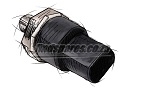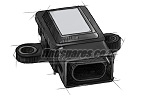Cars / ABS-System
Advertising
ABS - Cars
ABS (Antilock Braking System) is a safety system that allows the wheels of a motor vehicle to continue interacting with the road surface as directed by the driver of the vehicle while stopped. The system prevents the wheels from skidding. ABS generally offers improved vehicle control and decreases stopping distances on dry and slippery surfaces (pavements).
However, on slippery surfaces such as gravel, sand or snow covered roads, the ABS system can significantly increase braking distance. Since its initial widespread use in cars, anti-lock braking systems have developed considerably. The four main components in the system are ABS speed sensors, valves, pumps and controller. Recent versions not only prevent wheels from locking while braking, but also electronically control front and rear calipers.
These functions, depending on the specific capabilities and implementation, are known as electronic brake force distribution (EBD), traction control system, emergency brake assist and electronic stability control (ESC). Chrysler, along with Bendix Corporation imposed computerized, three-channel ABS systems on the four wheels, called Sure Brake. In 1971, General Motors introduced Trackmaster ABS rear wheels in Cadillac cars. In the same year, Nissan released EAL (Electro Anti-lock System), which became the first electronic ABS in Japan.
The modern ABS applies individual brakes to all four wheels fitted with special sensors and micro-controllers. ABS comes standard or optional on most vehicles produced today. Modern systems for electronic stability control, or ESC and ESP, is an evolution of the concept of ABS. These two new variants of ABS add a minimum of two additional sensors to improve the performance of the system.











